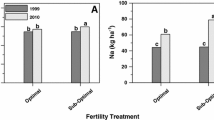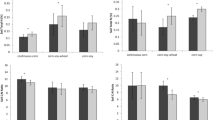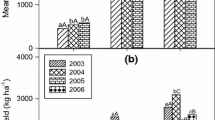Abstract
The effects of soil aeration, N fertilizer, and crop residue management on crop performance, soil N supply, organic carbon (C) and nitrogen (N) content were evaluated in two annual double-crop systems for a 2-year period (1994–1995). In the maize-rice (M-R) rotation, maize (Zea mays, L.) was grown in aerated soil in the dry season (DS) followed by rice (Oriza sativa, L.) grown in flooded soil in the wet season (WS). In the continuous rice system (R-R), rice was grown in flooded soil in both the DS and WS. Subplot treatments within cropping-system main plots were N fertilizer rates, including a control without applied N. In the second year, sub-subplot treatments with early or late crop residue incorporation were initiated after the 1995 DS maize or rice crop. Soil N supply and plant N uptake of 1995 WS rice were sensitive to the timing of residue incorporation. Early residue corporation improved the congruence between soil N supply and crop demand although the size of this effect was influenced by the amount and quality of incorporated residue. Grain yields were 13-20% greater with early compared to late residue incorporation in R-R treatments without applied N or with moderate rates of applied N. Although substitution of maize for rice in the DS greatly reduced the amount of time soils remained submerged, the direct effects of crop rotation on plant growth and N uptake in the WS rice crops were small. However, replacement of DS rice by maize caused a reduction in soil C and N sequestration due to a 33–41% increase in the estimated amount of mineralized C and less N input from biological N fixation during the DS maize crop. As a result, there was 11–12% more C sequestration and 5–12% more N accumulation in soils continuously cropped with rice than in the M-R rotation with the greater amounts sequestered in N-fertilized treatments. These results document the capacity of continuous, irrigated rice systems to sequester C and N during relatively short time periods.
Similar content being viewed by others
References
App A A, Santiago T, Daez C, Menguito C, Ventura W, Tirol A, Po J, Watanabe I, De Datta S K and Roger P A 1984 Estimation of the nitrogen balance for irrigated rice and the contribution of phototropic nitrogen fixation. Field Crops Res. 9, 17–27.
Azam F, Lodhi A and Ashraf M 1991 Availability of soil and fertilizer nitrogen to wetland rice following wheat straw treatment. Biol. Fertil. Soils 11, 97–100.
Bohlool B B, Ladha J K, Garrity D P and George T 1992 Biological nitrogen fixation for sustainable agriculture: a perspective. Plant Soil 141, 1–11.
Bremner J M and Mulvaney C S 1982 Nitrogen - Total. In Methods of Soil Analysis, Part 2. Eds. A L Page, R H Miller and D R Keeney. pp 595–623. Am. Soc. Agron., Madison, USA.
Bronson K F, Singh U, Neue H U and Abao E B Jr. 1997 Automated chamber measurements of methane and nitrous oxide flux in a flooded rice soil: II. Fallow period measurements. Soil Sci. Soc. Am. J. 61, 988–993.
Buresh R J and Austin E R 1988 Direct measurement of dinitrogen and nitrous oxide flux in flooded soils. Soil Sci. Soc. Am. J. 52, 681–688.
Cassman K G and Pingali P L 1995 Intensification of irrigated rice systems: Learning from the past to meet future challenges. Geo. J. 35, 299–305.
Cassman K G, De Datta S K, Olk D C, Alcantara J M, Samson M I, Descalsota J and Dizon M A 1995 Yield decline and the nitrogen economy of long-term experiments on continuous, irrigated rice systems in the tropics. In Soil management: Experimental basis for sustainability and environmental quality. Eds. R Lal and B A Stewart. pp 181–222. Lewis/CRC, Boca Raton, FL, USA.
Cassman K G, Gines G C, Dizon M A, Samson M I and Alcantara J M 1996a Nitrogen use efficiency in tropical lowland rice systems: Contributions from indigenous soil resources and applied nitrogen inputs. Field Crops Res. 47, 1–12.
Cassman K G, Dobermann A, Sta.Cruz P C, Gines G C, Samson M I, Descalsota J P, Alcantara J M, Dizon M A and Olk D C 1996b Soil organic matter and the indigenous nitrogen supply of intensive irrigated rice systems in the tropics. Plant Soil. 182, 267–278.
Cassman K G, Kropff M J, Gaunt J L and Peng S 1993 Nitrogen use efficiency of rice reconsidered - what are the key constraints. Plant Soil 155/156, 359–362.
Cassman K G, Peng S, Olk D C, Ladha J K, Reichardt W, Dobermann A and Singh U 1998 Opportunities for increased nitrogen use efficiency from improved resource management in irrigated rice systems. Field Crops Res. 56, 7–39.
Colberg P J 1988 Anaerobic microbial degradation of cellulose, lignin, oligolignols, and monoaromatic lignin derivates. In Biology of anaerobic microorganisms. Ed. A J B Zehnder. pp 333–372. Wiley, New York, USA.
De Datta S K, Buresh R J, Samson M I, Obcemea WN and Real J G 1991 Direct measurement of ammonia and denitrification fluxes from urea applied to rice. Soil Sci. Soc. Am. J. 55, 543–548.
Dobermann A, Dawe D, Roetter R and Cassman K G 2000 Reversal of rice yield decline in a long- term continuous cropping experiment. Agron. J. (In press).
Fillery I R P and Vlek P L G 1986 Reappraisal of the significance of ammonia volatilization as an N loss mechanism in flooded rice fields. Fert. Res. 9, 79–98.
Fillery I R P, Roger P A and De Datta S K 1986 Ammonia volatilization from nitrogen sources applied to rice fields: II. Floodwater properties and submerged photosynthetic biomass. Soil Sci. Soc. Am. J. 50, 86–91.
Freney J R, Leuning R, Simpson J R, Denmead O T and Muirhead W A 1985 Estimating ammonia volatilization from flooded rice fields by simplified techniques. Soil Sci. Soc. Am. J. 49, 1049–1054.
George T, Ladha J K, Buresh R J and Garrity D P 1993 Nitrate dynamics during the aerobic soil phase in lowland rice-based cropping systems. Soil Sci. Soc. Am. J. 57, 1526–1532.
GökMand Ottow J C G 1988 Effect of cellulose and straw incorporation in soil on total denitrification and nitrogen immobilization at initially aerobic and permanent anaerobic conditions. Biol. Fertil. Soils. 5, 317–322.
Greenland D J 1997 The sustainability of rice farming. CAB International and International Rice Research Institute, Wallingford, Oxon, UK, and Manila, Philippines.
Hasegawa T, Koroda Y, Seligman N G and Horie T 1994 Response of spikelet number to plant nitrogen concentration and dry weight in paddy rice. Agron. J. 86, 673–676.
Kempers A J and Zweers A 1986 Ammonium determination in soil extracts by the salicylate method. Commun. Soil Sci. Plant Anal. 17, 715–723.
Kennedy I R and Tchan Y-T 1997 Biological nitrogen fixation in non-leguminous field crops: Recent advances. Plant Soil 141, 93–118.
Koyama T and App A A 1979 Nitrogen balance in flooded rice soils. In Nitrogen and rice. pp 95–104. International Rice Research Institute (IRRI), Los Bañ os, Philippines.
Navone R 1964 Proposed method for nitrate potable waters. J. Am. Water Works Assoc. 56, 781–783.
Olk D C, Cassman K G, Randall E W, Kinchesh P, Sanger L J and Anderson J M 1996 Changes in chemical properties of organic matter with intensified rice cropping in tropical lowland soil. Europ. J. Soil. Sci. 47, 293–303.
Olk D C, Cassman K G, Simbahan G, Sta.Cruz P C, Abdulrachman S, Nagarajan R, Pham Sy Tan and Satawathananont S 1999 Interpreting fertilizer-use efficiency in relation to soil nutrient-supplying capacity, factor productivity, and agronomic efficiency. Nutr. Cycl. Agroecosyst. 53, 35–41.
Page A L, Miller R H and Keeney D R 1982 Methods of soil analysis, Part 2. Am. Soc. Agron., Madison, USA.
Patnaik S 1978 Natural sources of nutrients in rice soils. In Soils and Rice. pp 501–519. International Rice Research Institute (IRRI), Los Bañ os, Philippines.
Peng S, and Cassman K G 1998 Upper thresholds of nitrogen uptake rates and associated nitrogen fertilizer efficiencies in irrigated rice. Agron. J. 90, 178–185.
Rao D N and Mikkelsen D S 1977 Effect of rice straw additions on production of organic acids in a flooded soil. Plant Soil 47, 303–311.
Roger P A 1996 Biology and management of the floodwater ecosystem in ricefields. International Rice Research Institute (IRRI), Los Bañ os, Philippines. 250 p.
SAS 1988 SAS/STAT User's Guide. 6.03 edn. SAS Institute, Cary, NC, USA.
Sheehy J E, Dionora M J A, Mitchell P L, Peng S, Cassman K G, Lemaire G and Williams R L 1998 Critical nitrogen concentrations: Implications for high-yielding rice (Oryza sativa L.) cultivars in the tropics. Field Crops Res. 59, 31–41.
van Veen J A, Merckx R and Van De Geijn S C 1989 Plant-and soil related controls of the flow of carbon from roots through the soil microbial biomass. Plant Soil. 115, 179–188.
Witt C, Cassman K G, Ottow J C G and Biker U 1998 Soil microbial biomass and nitrogen supply in an irrigated lowland rice soil as affected by crop rotation and residue management. Biol. Fertil. Soils 28, 71–80.
Author information
Authors and Affiliations
Rights and permissions
About this article
Cite this article
Witt, C., Cassman, K., Olk, D. et al. Crop rotation and residue management effects on carbon sequestration, nitrogen cycling and productivity of irrigated rice systems. Plant and Soil 225, 263–278 (2000). https://doi.org/10.1023/A:1026594118145
Issue Date:
DOI: https://doi.org/10.1023/A:1026594118145




